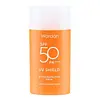What's inside
What's inside
 Key Ingredients
Key Ingredients

 Benefits
Benefits

 Concerns
Concerns

No concerns
 Ingredients Side-by-side
Ingredients Side-by-side

Water
Skin ConditioningDibutyl Adipate
EmollientC12-15 Alkyl Benzoate
AntimicrobialPropylheptyl Caprylate
EmollientDiethylamino Hydroxybenzoyl Hexyl Benzoate
UV FilterTris-Biphenyl Triazine
UV AbsorberSucrose Polystearate
EmollientEthylhexyl Triazone
UV AbsorberEthylhexyl Salicylate
UV AbsorberMethylene Bis-Benzotriazolyl Tetramethylbutylphenol
UV FilterGlycerin
HumectantPolyester-7
Skin ConditioningPolymethyl Methacrylate
Neopentyl Glycol Diheptanoate
EmollientUndecane
EmollientBis-Ethylhexyloxyphenol Methoxyphenyl Triazine
Skin ConditioningCetearyl Alcohol
EmollientDecyl Glucoside
CleansingDisodium EDTA
Disodium Cetearyl Sulfosuccinate
CleansingCetyl Palmitate
EmollientTridecane
PerfumingBisabolol
MaskingPhenoxyethanol
PreservativeChlorphenesin
AntimicrobialXanthan Gum
EmulsifyingPropanediol
SolventParfum
MaskingButylene Glycol
HumectantDisodium Phosphate
BufferingPropylene Glycol
HumectantArtemisia Capillaris Flower Extract
Skin ConditioningWater, Dibutyl Adipate, C12-15 Alkyl Benzoate, Propylheptyl Caprylate, Diethylamino Hydroxybenzoyl Hexyl Benzoate, Tris-Biphenyl Triazine, Sucrose Polystearate, Ethylhexyl Triazone, Ethylhexyl Salicylate, Methylene Bis-Benzotriazolyl Tetramethylbutylphenol, Glycerin, Polyester-7, Polymethyl Methacrylate, Neopentyl Glycol Diheptanoate, Undecane, Bis-Ethylhexyloxyphenol Methoxyphenyl Triazine, Cetearyl Alcohol, Decyl Glucoside, Disodium EDTA, Disodium Cetearyl Sulfosuccinate, Cetyl Palmitate, Tridecane, Bisabolol, Phenoxyethanol, Chlorphenesin, Xanthan Gum, Propanediol, Parfum, Butylene Glycol, Disodium Phosphate, Propylene Glycol, Artemisia Capillaris Flower Extract
Water
Skin ConditioningDicaprylyl Carbonate
EmollientGlycerin
HumectantDiethylamino Hydroxybenzoyl Hexyl Benzoate
UV FilterDipropylene Glycol
HumectantHydrogenated Polyisobutene
EmollientDibutyl Adipate
EmollientEthylhexyl Triazone
UV AbsorberNiacinamide
SmoothingEthylhexyl Olivate
Skin ConditioningCetearyl Olivate
Ethyl Hexanediol
SolventSodium Acrylates Copolymer
Sorbitan Olivate
EmulsifyingPolyglyceryl-4 Oleate
EmulsifyingGlyceryl Caprylate
EmollientDisodium EDTA
Adenosine
Skin Conditioning1,2-Hexanediol
Skin ConditioningHyaluronic Acid
HumectantTocopherol
AntioxidantEthylhexylglycerin
Skin ConditioningWater, Dicaprylyl Carbonate, Glycerin, Diethylamino Hydroxybenzoyl Hexyl Benzoate, Dipropylene Glycol, Hydrogenated Polyisobutene, Dibutyl Adipate, Ethylhexyl Triazone, Niacinamide, Ethylhexyl Olivate, Cetearyl Olivate, Ethyl Hexanediol, Sodium Acrylates Copolymer, Sorbitan Olivate, Polyglyceryl-4 Oleate, Glyceryl Caprylate, Disodium EDTA, Adenosine, 1,2-Hexanediol, Hyaluronic Acid, Tocopherol, Ethylhexylglycerin
 Reviews
Reviews

Ingredients Explained
These ingredients are found in both products.
Ingredients higher up in an ingredient list are typically present in a larger amount.
Dibutyl Adipate is an emollient and solvent. It is created from butyl alcohol and adipic acid.
As a solvent, Dibutyl Adipate helps mix and disperse ingredients evenly.
Dibutyl Adipate is soluble in water and organic solvents. It does not absorb UV rays.
Learn more about Dibutyl AdipateDiethylamino Hydroxybenzoyl Hexyl Benzoate (DHHB) is a chemical UV-A absorber. It is formulated for high UVA protection (320-400 nm).
DHHB is well-liked for:
DHHB has been approved by the EU, Japan, Taiwan, and South America for use up to 10%. Unfortunately, it has not been approved for use in the US or Canada due to slow regulatory processes.
This ingredient is soluble in oils, fats, and lipids.
Learn more about Diethylamino Hydroxybenzoyl Hexyl BenzoateDisodium EDTA plays a role in making products more stable by aiding other preservatives.
It is a chelating agent, meaning it neutralizes metal ions that may be found in a product.
Disodium EDTA is a salt of edetic acid and is found to be safe in cosmetic ingredients.
Learn more about Disodium EDTAEthylhexyl Triazone is a modern chemical sunscreen that protects from UV-B radiation.
It is the most effective of existing UV-B filters, as it provides the highest level of photo-stable absorption. It protects from the entire UV-B range (280 to 320nm), with it's highest level of protection at 314nm.
Ethylhexyl Triazone is oil soluble, oderless and colorless, which mean it is able to be incorporated into a variety of different formulations.
It is not currently available within the United States due to slow changing FDA regulations. Outside of the US, it is used in formulations at concentrations up to 5%.
Learn more about Ethylhexyl TriazoneGlycerin is already naturally found in your skin. It helps moisturize and protect your skin.
A study from 2016 found glycerin to be more effective as a humectant than AHAs and hyaluronic acid.
As a humectant, it helps the skin stay hydrated by pulling moisture to your skin. The low molecular weight of glycerin allows it to pull moisture into the deeper layers of your skin.
Hydrated skin improves your skin barrier; Your skin barrier helps protect against irritants and bacteria.
Glycerin has also been found to have antimicrobial and antiviral properties. Due to these properties, glycerin is often used in wound and burn treatments.
In cosmetics, glycerin is usually derived from plants such as soybean or palm. However, it can also be sourced from animals, such as tallow or animal fat.
This ingredient is organic, colorless, odorless, and non-toxic.
Glycerin is the name for this ingredient in American English. British English uses Glycerol/Glycerine.
Learn more about GlycerinWater. It's the most common cosmetic ingredient of all. You'll usually see it at the top of ingredient lists, meaning that it makes up the largest part of the product.
So why is it so popular? Water most often acts as a solvent - this means that it helps dissolve other ingredients into the formulation.
You'll also recognize water as that liquid we all need to stay alive. If you see this, drink a glass of water. Stay hydrated!
Learn more about Water